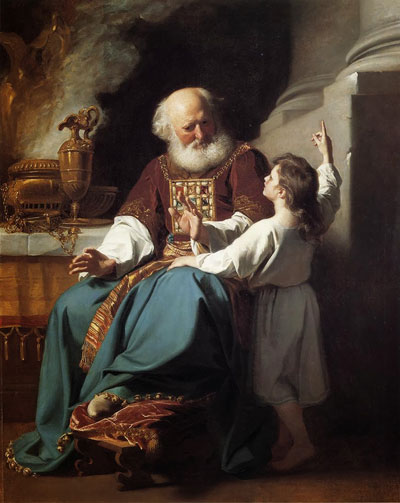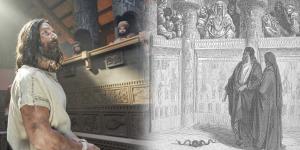You are here
Why is a Seer Greater than a Prophet?

Mosiah 8:15
The Know
In Mosiah 8, Ammon, “a strong and mighty man, and a descendant of Zarahemla” (Mosiah 7:3), included a discourse on the nature of prophethood, seership, and divine translation. In response to King Limhi’s request for a translation of some sacred records (Mosiah 8:11–12), he spoke of “a man [Mosiah] that can translate the records; for he has wherewith that he can look, and translate all records that are of ancient date; and it is a gift from God.” The instruments of translation, which Ammon called “interpreters,” could only be used when divinely commissioned. “Whosoever is commanded to look in them,” Ammon taught, “the same is called seer” (Mosiah 8:13).
With this information in mind, Limhi reasoned that “a seer is greater than a prophet” (Mosiah 8:15). Ammon concurred, and explained,
A seer is a revelator and a prophet also; and a gift which is greater can no man have, except he should possess the power of God, which no man can; yet a man may have great power given him from God. But a seer can know of things which are past, and also of things which are to come, and by them shall all things be revealed, or, rather, shall secret things be made manifest, and hidden things shall come to light, and things which are not known shall be made known by them, and also things shall be made known by them which otherwise could not be known. (Mosiah 8:16–17)
Ammon drew a distinction between prophethood and seership. A prophet, a spokesperson for God, can with divine authority foretell what would, could, or should occur if people behave in certain ways (such as promised blessings for keeping the commandments or promised woes for falling into apostate behavior).1 While each dispensation has great Prophets (capital P) who stand at the head of God’s covenant people or God’s church with priesthood keys, individuals, both men and women, can act as prophets or prophetesses (lowercase P) in their respective lives, families, and ecclesiastical roles (cf. Exodus 15:20; Numbers 11:29; Judges 4:4; Isaiah 8:3; 2 Kings 22:14; Luke 2:36; Acts 11:27; 21:10; Revelation 19:10).
A seer, however, is more than a prophet who pronounces divine judgment or foretells the future. A seer is one who “through faith, might work mighty miracles” by the use of “means” (divine instruments) prepared by God (Mosiah 8:18).2 As Ammon explained, seership is greater than prophethood because a seer unlocks what happened in the past, including mysteries, secrets, obscured teachings, lost scripture, and hidden knowledge. As Limhi acknowledged, the instruments of seership are “doubtless prepared for the purpose of unfolding all such mysteries to the children of men” (Mosiah 8:19). In this way, a seer goes beyond the gifts granted to prophets and is therefore “greater” both regarding power and responsibility.
The Why
The Book of Mormon’s description of seership finds a home in the world of ancient Israel. After all, “The Bible . . . mentions people receiving spiritual manifestations by means of physical objects such as rods, a brass serpent on a pole . . . an ephod (a part of the priestly clothing that included two precious stones), and the Urim and Thummim.”3 Indeed, seers are mentioned in the biblical record as having had a presence in Israel’s society (1 Samuel 9:9, 11, 19; 2 Samuel 15:27; 24:11; 2 Kings 17:13; Micah 3:7; Amos 7:12; Isaiah 30:10), and the enigmatic “Urim and Thummim” of the Old Testament (Exodus 28:30; Leviticus 8:8; Numbers 27:21; Deuteronomy 33:8; 1 Samuel 28:6) appear to have had an oracular function in biblical religion.4 The Book of Mormon in this instance is thus consistent with the biblical tradition.
Joseph Smith himself is designated a “seer” in the Book of Mormon and the Doctrine and Covenants (2 Nephi 3:6; Doctrine and Covenants 21:1). He can rightly be called such since with divine instruments he not only translated the Book of Mormon but also glimpsed the distant past of ancient America.5 As Richard E. Turley Jr., Robin S. Jensen, and Mark Ashurst-McGee explained, “Seer stones . . . appear in historical accounts describing Joseph Smith and the Book of Mormon translation.”6 The exact nature of the Book of Mormon translation is not fully understood.7 Nevertheless, historical evidence indicates that Joseph the Seer first saw and then read the translated words of the Book of Mormon that appeared in either the Nephite “interpreters” (also called “spectacles” or later the Urim and Thummim) that were recovered with the plates or in his individual seer stone that he had previously used in certain folk magic activities.8
With the restoration of God’s ancient order in our time came the gift of seership again. Steven C. Walker commented, “The ancient calling of seer remains active through modern times,” as “in the modern Church, members of the First Presidency and the Quorum of the Twelve Apostles serve as seers. These fifteen apostolic officials are designated prophets, seers, and revelators who direct the Church by means of divine revelation.”9
Further Reading
Steven C. Walker, “Seer,” in The Encyclopedia of Mormonism, ed. Daniel H. Ludlow (New York, N. Y.: Macmillan, 1992), 3:1292–1293.
Richard E. Turley Jr., Robin S. Jensen, and Mark Ashurst-McGee, “Joseph the Seer,” Ensign, October 2015, 49–54.
Michael Hubbard MacKay and Gerrit J. Dirkmaat, From Darkness Unto Light: Joseph Smith's Translation and Publication of the Book of Mormon (Provo, UT and Salt Lake City, UT: Religious Studies Center, Brigham Young University, and Deseret Book, 2015).
- 1. See generally Ralph A. Britsch and Todd A. Britsch, “Prophet: Prophets,” in The Encyclopedia of Mormonism, 4 vols., ed. Daniel H. Ludlow (New York, NY: Macmillan Publishing, 1992), 3:1164–1167; David Noel Freedman, “Prophet: Biblical Prophets,” in The Encyclopedia of Mormonism, 3:1167–1170.
- 2. According to Joseph Smith’s 1838 history, the angel Moroni indicated to the boy prophet that “the possession and use of [seer stones] were what constituted ‘seers’ in ancient or former times” (Joseph Smith—History 1:35).
- 3. Richard E. Turley Jr., Robin S. Jensen, and Mark Ashurst-McGee, “Joseph the Seer,” Ensign, October 2015, 49.
- 4. Cornelis Van Dam, The Urim and Thummim: A Means of Revelation in Ancient Israel (Winona Lake, IN: Eisenbrauns, 1997).
- 5. Lucy Mack Smith recalled that during his encounters with Moroni in the mid-1820s her son “would occasionally give [the Smith family] some of the most amusing recitals that could be imagined: he would describe the ancient inhabitants of this continent; their dress, mode of travelling, and the animals upon which they rode; their cities, and their buildings, with every particular; he would describe their mode of warfare, as also their religious worship. This he would do with as much ease, seemingly, as if he had spent his whole life with them.” Lucy Mack Smith, History, 1845, 87, online at www.josephsmithpapers.org. While skeptics might dismiss this as the young prophet telling tall tales or spinning yarn, it is also possible to interpret this as Joseph utilizing his newly-honed seeric abilities under Moroni’s tutelage.
- 6. Turley, Jensen, and Ashurst-McGee, “Joseph the Seer,” 50.
- 7. For an accessible overview, see the Gospel Topics essay “Book of Mormon Translation.
- 8. The literature on the translation of the Book of Mormon and Joseph Smith’s involvement with folk magic is extensive. For some key works, see Royal Skousen, “Translating the Book of Mormon: Evidence from the Original Manuscript,” in Book of Mormon Authorship Revisited: The Evidence for Ancient Origins, ed. Noel B. Reynolds (Provo, UT: FARMS, 1997), 61–93; Mark Ashurst–McGee, “A Pathway to Prophethood: Joseph Smith Junior as Rodsman, Village Seer, and Juedo-Christian Prophet” (Master’s Thesis, Utah State University, 2000); Brant A. Gardner, The Gift and Power: Translating the Book of Mormon (Salt Lake City, UT: Greg Kofford, 2011); Kerry Muhlestein, “Seeking Divine Interaction: Joseph Smith’s Varying Searches for the Supernatural,” in No Weapon Shall Prosper: New Light on Sensitive Issues, ed. Robert L. Millet (Provo, UT and Salt Lake City, UT: Religious Studies Center, Brigham Young University, 2011), 77–91; Roger Nicholson, “The Spectacles, the Stone, the Hat, and the Book: A Twenty-first Century Believer’s View of the Book of Mormon Translation,” Interpreter: A Journal of Mormon Scripture 5 (2013): 121–190; Michael Hubbard MacKay and Gerrit J. Dirkmaat, “Firsthand Witness Accounts of the Translation Process,” in The Coming Forth of the Book of Mormon: A Marvelous Work and a Wonder, ed. Dennis L. Largey et al. (Provo, UT and Salt Lake City, UT: Religious Studies Center, Brigham Young University, and Deseret Book, 2015), 61–79; From Darkness Unto Light: Joseph Smith’s Translation and Publication of the Book of Mormon (Provo, UT and Salt Lake City, UT: Religious Studies Center, Brigham Young University, and Deseret Book, 2015); Stanford Carmack, “Joseph Smith Read the Words,” Interpreter: A Journal of Mormon Scripture 18 (2016): 41–64; Richard Lyman Bushman, “Joseph Smith and Money Digging,” in A Reason for Faith: Navigating LDS Doctrine and Church History, ed. Laura Harris Hales (Provo, UT and Salt Lake City, UT: Religious Studies Center, Brigham Young University, and Deseret Book, 2016), 1–6.
- 9. Steven C. Walker, “Seer,” in The Encyclopedia of Mormonism, 3:1292–1293.
KnoWhy Citation
Related KnoWhys
Subscribe
Get the latest updates on Book of Mormon topics and research for free








